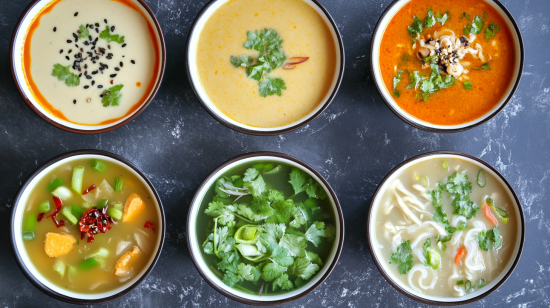Introduction
What Makes Soup Comforting?
What is the secret ingredient in soup ? Soup’s ability to soothe comes from its combination of warm liquids, savory flavors, and nourishing ingredients. It’s a meal that transcends cultures, offering both sustenance and comfort. However, the depth of flavor in soup often relies on subtle enhancements that make each spoonful unforgettable.
Overview of the Secret Ingredient Concept
The secret ingredient is that elusive element that makes a soup extraordinary. It’s not just about adding something unexpected—it’s about balance, depth, and harmony. Whether it’s a pinch of spice or a splash of vinegar, a well-chosen secret ingredient can transform a basic recipe into a masterpiece.
Table of Contents
Defining a Secret Ingredient
Why Do Some Soups Taste Better?
The magic of certain soups lies in their complexity. A secret ingredient often adds an extra layer of flavor, creating a harmonious blend that keeps people guessing. It’s not always about being exotic; sometimes, the secret is using a familiar ingredient in an unexpected way.
The Psychology of a “Secret” Ingredient
A secret ingredient intrigues diners because it adds an element of mystery. It sparks curiosity and creates a sense of exclusivity, making the soup feel special. This psychological appeal is part of what makes a secret ingredient so powerful in cooking.
Historical Use of Soup Enhancers
Ancient Practices of Using Unique Ingredients in Soups
The concept of enhancing soups with secret ingredients is nothing new. Ancient cultures used everything from fermented fish sauce in Asia to herbs in Europe to enrich their broths. These early practices laid the foundation for the complex flavors we appreciate today.
For example:
- Roman Cuisine: Garum (fermented fish sauce) was a common soup enhancer.
- Chinese Soups: Dried scallops or goji berries were used for depth and nutrition.
- Native American Stews: Wild herbs and roots added earthy, unique flavors.
These traditions remind us that secret ingredients are deeply rooted in culinary history.
Common Secret Ingredients
Examples: Spices, Herbs, Fats, and Umami-Rich Components
Many secret ingredients fall into a few key categories:
- Spices: A dash of nutmeg, cinnamon, or smoked paprika can add warmth and depth.
- Herbs: Fresh thyme, bay leaves, or cilantro elevate the aroma.
- Fats: A swirl of butter or cream creates richness and a velvety texture.
- Umami-Rich Components: Soy sauce, miso paste, or Parmesan cheese rind enhances savoriness.
Using these elements strategically ensures a well-rounded and flavorful soup.
The Role of Umami
What Is Umami?
Umami, often referred to as the “fifth taste,” is a savory flavor that adds depth and complexity to dishes. It’s found naturally in foods like mushrooms, tomatoes, and aged cheeses. Incorporating umami into soups creates a deeply satisfying flavor profile.
Learn more about leveraging simple ingredients by visiting what are russet potatoes best for?.
How Does It Elevate Soups?
Adding umami-rich ingredients like miso paste, soy sauce, or dried shiitake mushrooms intensifies the soup’s savoriness. This creates a harmonious balance that keeps each bite interesting and full of flavor.
Sweet Elements in Savory Soups
Surprising Uses of Sugar, Honey, or Fruit in Savory Soups
While soup is often associated with savory flavors, a touch of sweetness can make all the difference. Sugar, honey, or even fruits like apples and pears can balance acidity and enhance other flavors.
For example:
- Tomato Soup: A pinch of sugar neutralizes acidity.
- Carrot or Squash Soups: A drizzle of honey accentuates natural sweetness.
- Asian Soups: Adding dates or dried fruits balances spices.
These subtle additions create complexity without overwhelming the savory elements.Experiment with ingredients highlighted in dishes like traditional Mexican breakfast recipes.
Acid for Balance

Lemon, Vinegar, and Other Acidic Components in Soups
Acid is an often-overlooked but essential component of a great soup. Ingredients like lemon juice, vinegar, or even buttermilk add brightness and balance, cutting through richness and preventing flavors from becoming too heavy.
Examples of Acidic Ingredients for Soup:
- Lemon or Lime Juice: Brightens vegetable soups or lentil stews.
- Vinegars: Balsamic or apple cider vinegar adds a tangy finish.
- Tomatoes: Naturally acidic, they enhance broths and add complexity.
Adding acidity at the end of cooking ensures the soup retains a fresh and vibrant flavor.
What Is the Secret Ingredient in Soup? Unlocking the Key to Flavorful Soups
Soup is a timeless dish that can be comforting, nourishing, and flavorful. But the question remains: “What is the secret ingredient in soup?” The answer lies in understanding how specific components work together to enhance flavor and create depth. In this guide, we’ll uncover the role of secret ingredients and how you can experiment to make your soups unforgettable.
Fats and Their Role
Butter, Cream, and Oils as Secret Flavor Enhancers
Fats are essential in creating a rich, velvety texture and amplifying the flavors of your soup. Ingredients like butter, cream, and oils not only add richness but also act as carriers for other flavors, ensuring every bite is satisfying.
- Butter: Adds a silky finish and enhances the natural sweetness of vegetables.
- Cream: Creates a luxurious texture in soups like tomato bisque or chowders.
- Oils: Drizzle high-quality olive oil or sesame oil over soup for a burst of flavor.
Incorporating fats strategically can elevate your soup, making it more indulgent without overpowering the other ingredients.
Fresh vs. Dried Herbs
The Effect of Herb Selection and Timing on Flavor
Herbs are powerful tools for enhancing the taste of soup, but choosing between fresh and dried can significantly impact the final flavor.
- Fresh Herbs: Provide vibrant, bright flavors. Add them near the end of cooking to retain their aroma and freshness. Examples include basil, parsley, and cilantro.
- Dried Herbs: Offer concentrated flavors. Add them early in the cooking process to allow the flavors to meld. Examples include oregano, thyme, and rosemary.
Balancing the use of fresh and dried herbs ensures a complex flavor profile, helping your secret ingredient shine.
Secret Ingredient Spotlight
Examples: Fish Sauce, Miso Paste, Parmesan Rinds, and Anchovies
Secret ingredients are often subtle yet transformative additions that take your soup to the next level. Here are some standout examples:

- Fish Sauce: Adds umami and depth, particularly in broths or Asian-inspired soups.
- Miso Paste: Provides a savory, slightly sweet flavor that pairs well with vegetables and seafood.
- Parmesan Rinds: Simmer in the broth for a rich, cheesy undertone.
- Anchovies: Disintegrate into the soup, adding a salty, umami kick without being overpowering.
These ingredients prove that small additions can make a big impact on the overall flavor.
Broth vs. Stock: The Base for “What Is the Secret Ingredient in Soup?”
Why a Strong Foundation Elevates Your Secret Ingredient
The base of your soup—whether broth or stock—is critical to its success. A well-crafted base enhances the effectiveness of your secret ingredient and creates a solid foundation for the dish.
- Broth: Lighter and made from simmered meat or vegetables, it’s ideal for delicate soups.
- Stock: Richer, made from bones, and provides a more robust flavor for hearty soups.
Pairing the right base with your secret ingredient ensures a harmonious blend of flavors, allowing each component to shine.
Cultural Perspectives: How Different Regions Define “What Is the Secret Ingredient in Soup?”
Exploring Secret Ingredients in Soups from Around the World
Around the globe, secret ingredients play a vital role in creating iconic soups:
- Vietnam: Pho often includes charred ginger and star anise for depth.
- Italy: Minestrone gains richness from a Parmesan rind simmered in the broth.
- Japan: Miso soup showcases miso paste for its signature umami flavor.
- Mexico: Pozole’s unique taste comes from hominy and a hint of lime.
Exploring these cultural perspectives highlights how secret ingredients are deeply tied to tradition and regional flavors.
How to Experiment at Home to Discover Your Own Secret Ingredient
Tips for Finding “What Is the Secret Ingredient in Soup?”
Discovering your secret ingredient involves creativity and trial-and-error. Here’s how to start:
- Start Small: Add a pinch of an unusual spice or a splash of vinegar and taste as you go.
- Experiment with Textures: Incorporate crunchy toppings like toasted seeds or creamy elements like yogurt.
- Borrow from Other Cuisines: Use ingredients like harissa, tamarind, or coconut milk for a unique twist.
- Note What Works: Keep a journal of what ingredients and combinations enhance your soup.
By experimenting, you can find a signature element that makes your soup truly yours.
FAQs About “What Is the Secret Ingredient in Soup?”
What is the secret ingredient in soup that enhances umami?
Ingredients like fish sauce, miso paste, and soy sauce are excellent for adding umami.
Can I use sweet ingredients in savory soups?
Yes, a touch of sugar, honey, or fruit can balance acidity and enhance the overall flavor.
Should I always use homemade stock for soup?
While homemade stock is ideal, high-quality store-bought options work well with the right seasoning.
How can I fix a soup that tastes bland?
Add a splash of vinegar, a pinch of salt, or a secret ingredient like soy sauce to bring the flavors to life.
Are secret ingredients always exotic or hard to find?
Not at all! Common pantry items like lemon juice, butter, or Parmesan rinds can serve as secret ingredients.
How can I make vegan soups rich in flavor?
Use umami-rich ingredients like nutritional yeast, miso paste, or dried mushrooms to enhance depth.
Conclusion
The answer to “What is the secret ingredient in soup?” lies in creativity, balance, and thoughtful experimentation. Whether it’s the richness of fats, the complexity of umami, or the bright touch of acidity, these elements work together to transform ordinary soups into extraordinary culinary experiences. By exploring cultural perspectives and trying new ingredients, you can create soups that are not only flavorful but also uniquely yours.


2 thoughts on “What Is the Secret Ingredient in Soup?”